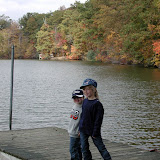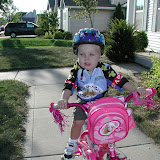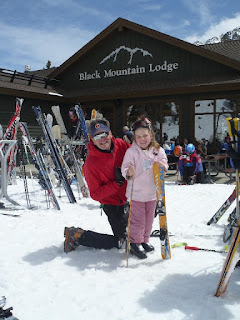Today I competed in the Lytle Park Triathlon in Mattoon, Illinois. It was the last triathlon I plan to race this season. Last year, this was the second tri in which I had ever competed and the first for which split times were recorded. Thus it would be the first opportunity to gauge my progress this year in swimming, cycling, running, as well as the important but often overlooked transitions.
The weather for the race was just about perfect. My car thermometer read a brisk 54 degrees when I left my home just after 5:30 am. The temperature rose to 61 degrees in Mattoon by the 8 am start with 83% humidity and north-northeasterly winds of just 3 mph (which I would only learn later from checking the history on the weather channel online). It would feel a little cool for a moment getting out of the water and onto the bike, but race day adrenaline and elevated heart rate would mask it quite well. The conditions would be very welcome for the run.
I arrived at the start at about 6:45 am, picked up my packet, and readied my bike for a short warm-up ride. I took my other gear into the transition area to stake out a spot. The bike racks in the transition area looked to be about half full, but there wasn't a whole lot of space given the eventual turnout of about 75 athletes. I chose a rack with about 4 bikes on it that seemed spacious enough for at least 6 or 7.
A certain female competitor whom I recognized from previous races was stretching nearby and informed me rather sternly that I could not place my stuff there because someone else had claimed the spot and was out for a warm-up ride. I thought it was quite rude of her, especially given the fact that the rack could have easily accommodated at least 1 or 2 more bikes in addition to the one that was out for a warm-up. The bikes present on the rack were all facing the same direction. Proper triathlon etiquette would dictate that when space is at a premium, bikes should be staggered so that neighbors face opposite directions. This makes best use of the available space and allows more room for placing gear on the ground next to the bikes.
I figured the best thing for me to do would be to just find another spot. I did just that at a rack across the aisle. Someone's towel was laid out on one side at the end of the rack, but there was no bike, suggesting that its owner was also out for a warm-up. I placed my bike nearby, but facing the opposite direction, so as not to interfere with the owner of the towel. Then the woman arose from her stretch to accost me for placing my bike over the towel, whose owner apparently was a friend of hers. I explained that my bike was facing the other direction and thus should not interfere. She protested that the other person would not be able to get to her towel with my bike tire in the way. What she failed to appreciate, was that the towel should not have been placed so as to conflict with a bike properly mounted on the rack. Gear should be set back a few feet from crossbar at the center of the rack so as to not senselessly render useless 2 feet of perfectly good rack real estate. Ugh! I know this woman's name because she is usually the top female finisher at the Mattoon races and I would need to beat her to avoid being "chicked." (Yes, I'll admit to a bit of a fragile male ego when it comes to athletic contests.) Nonetheless, she'll remain nameless here to keep my rant from popping up in a list of search results for her name. I certainly don't want to make it personal and slanderous. Maybe she was just in a pre-race bubble and did not understand or appreciate that space was getting tight.
Anyway, it wasn't worth getting my blood boiling before the race, so I moved my bike to a third rack with some extra space that was not in the most desirable location. It was tucked into a corner near a tree and was furthest from the bike exit. While I was moving my stuff, the owner of the towel returned with her bike and apologized. I responded that it was OK, but that she should be prepared to make room for more bikes on her rack. Registration was open for another half hour and participants continued to file into the parking lot. I did tack her friend's comments onto my mental "bulletin board" to fuel my motivation to chase her down on the course. The start order would be by age group, with women before men, so she would be out on the course several minutes ahead of me.
After getting my gear situated, I took my bike out for a short warm-up. The wind was very calm and at the time I did not know what direction it was coming from. Even a subtle wind can make a difference on the bike and I wanted to know how to dose my effort on the out-and-back course. If I would face a headwind on any part of the route, I would pedal a little harder there and try to recover on the tailwind. Knowing that the winds were so light and the differences between headwind, tailwind, and crosswind would be subtle, I warmed up with a T-shirt, hoping that its flapping would help me discern the wind direction. I went out about a half mile before turning back and still had no idea which way the wind was blowing. My T-shirt seemed to drag on me about the same in all directions. Perhaps the wind had just about died altogether, but I knew there was a good chance it would pick up slightly by the time I got out on the road in the race.
I returned and racked my bike and headed over to start area for the pre-race meeting. The swim would take place in the Lytle Park Pool. The pool was oval-shaped with a zero-depth entry on the end we would start, tapering to a depth of 10 feet on the far end. There were no lap lanes or lines on the pool bottom and the M-shaped swim course was marked with 3 buoys. The swim had something of an open-water feel, but on a small scale and without the smell of gasoline and fish that characterized my lake-swim triathlons.

The Swim Course
The swim distance was advertised as 300 meters, which must be a gross overstatement. Just looking at the pool (and the swim splits that other competitors and I put up), it cannot be more than 75 meters across. The zero depth entry also allows one to run for much of the start and finish of the swim. The starter sent us into the water one at a time, at 15 second intervals. Last year, the start order was based on each person's estimate of his own swim time and we lined up from fastest to slowest. It was a bit awkward since last year was the first edition of the race and no one really knew how fast he would swim. Imperfect as it was, it seemed to work a little better than starting by age group. I went out harder than I usually do in the swim start and passed a few people in the water. By the time I approached the third buoy, there was a full-scale pile up. I was smacking other people's legs and had to pull up into a slow breast stroke. Once I rounded the buoy, I could slide over into my own "lane" and kick it up again until the water became shallow enough to stand up and run.
There was probably about 50 meters of running from the pool to the transition area. Part of it was over a gravely stretch of sidewalk that the organizers had covered with a very thin strip of astroturf. It didn't seem to help much. I was very deliberate in transition with putting on my singlet, helmet, and sunglasses, but didn't rush so much that I would risk forgetting something. Following my usual routine just outside the transition, I placed my right foot inside my bike shoe, mounted the bike, and pedaled away with my left foot on top of the bike shoe. A left turn out of the parking lot would be followed pretty closely by another left turn and then a right before we would head out of town. I decided to wait until after the turns to get into my left shoe and fasten both shoe straps.
Once we left town heading north, the road surface turned to smooth asphalt. The entire bike course was very flat, with only very subtle grade changes that took riders over stretches of slightly uphill "false flats" followed by morale-boosting gradual downgrades. There were no flagpoles or other cues to solve the mystery of the wind direction. The mature corn stalks were not moving much at all. I was mostly holding between 21 and 22 mph on way out. On a flat course of 12.5 miles, on good roads, and in calm winds, I would expect to average at least 23 mph. I thought to myself "I sure hope I am in a headwind." About a mile or so from the turn around, I spotted my friend from the bike rack heading the other way. I didn't know exactly how far ahead of me she started, but it seemed like I was gaining ground. I know from past experience that she is a very strong swimmer and pretty good runner, but not at all dominant on the bike. She was in my crosshairs.
I accelerated out of the turnaround and then settled back onto my aerobars. I felt a little spring in my cleats and was relieved to sense a mild tailwind that would help carry me home. I had avoided being passed on the bike through the turnaround, but I knew there was one guy on course that could certainly overtake me. Martin Gruebele, a German-Austrian chemistry professor from Champaign whom I recently met through the Prairie Cycle Club and Wild Card Cycling Team, was coming toward me about 400 meters from the turnaround. Martin is 44 years old and rides very fast, despite claiming that he never really exercised much until he decided he needed to do something about an extra 10 pounds that appeared around his midsection after he turned 40. He usually averages 25-26 mph on his time trial machine. A couple miles down the road, I heard the whirring approaching from behind. "That must be Martin" I said aloud. He lifted his right hand slighly from the end of the aerobar to wave. "What took you so long?" I asked. "The swim," he replied as he overtook me. If Martin has a weakness, it is the swim, but the ultra-short swim didn't factor much in this race. I did not have the legs to match his pace, but it was very motivating to have someone in front of me as a "carrot". I just imagined that he was towing me along as I lifted my pace a bit to try to keep him in sight to the finish.
Officially I finished the bike leg in 32:52.95 with an average speed of 22.8 mph, which included time to mount the bike and get into my shoes at one end and dismount at the other. My GPS computer recorded an average of 23.3 mph over most of the route except for the first quarter mile or so. I was pretty satisfied with the result, especially since I eased up a bit over the last mile or so to recover for the run.

Bike Speed Profile: Even a little wind makes a difference on a solo ride!
I had really hoped to finish this race with a strong run, given that this would be my last tri of the season. In addition to wanting to catch her on the course, I was motivated by the thought of taking a vacation from running, my least favorite part of triathlon. I passed one guy almost immediately on the run, but otherwise felt rather flat. I decided to just try to keep a steady pace on the way out, then try to lift it a bit after the turn.
The run course began with a loop around the park, then exited to Western Avenue, heading toward downtown Mattoon. Just before hitting downtown, we looped around one city block and turned for home. I never did see her on the way out, but I did see Martin exiting the turnaround block just as I entered it. She must have been in the turnaround block at the time. The next time I saw her was after I exited the loop and was heading for home. She was maybe 200 meters ahead. Given the differential in our start times, I knew I had her beat. Then she dropped into a walk and grabbed her side. This was a sweet sight. With a spring in my stride, the motivation to lift the pace was right there in front of me. The possibility of catching her on the course was looking pretty real. My head was spinning for things I could say as I dropped the hammer. "You should have been nicer to me at the bike rack" was one I repeated in my head a few times. She managed to restart her run, but the gap was closing. As we approached the park, she was probably only a block and a half ahead but she seemed to lift the pace with the finish line within reach.
The course then looped back around the park, in the opposite direction from the start, to complete the last 400 meters or so. During this time, I had lost site of her around the turns as two pairs of new footsteps approached from behind. The ingredients could not have been better to cue up my finishing kick, but as I dug for it, I just came up empty. The two guys passed me with about 200 meters to go and I had no response. From the markings on their calves, I could see that they were younger. One was 33 and so had started at least 15 seconds ahead of me. The other was 16. Part of me wanted to chase them down, but I rested on the reality that as long as I finished within 15 seconds, I would beat them both. I kept the gap from growing, but was still disappointed in my inability to kick to the finish. The whole run felt quite average and that I had underachieved on it. However, my training has pretty much been on cruise control for the last four weeks and I had only run once in the week prior. I reaped what I had sowed.
As I crossed the line, I noticed her on the ground, lying back on her elbows. I so wanted to say something but didn't have the heart to kick a fellow competitor who was so obviously down. I have been there myself. The "what would Jesus do?" adage crossed my mind as I walked by to leave well enough alone. Actually, Jesus probably would have said something genuinely sympathetic, but the best I could muster was to adhere to one of my mother's old favorites: "If you can't say something nice, don't say anything at all." She was still the top female finisher and I still had the satisfaction of beating her.
Despite not meeting my expectations on the run, I came away with the top finish in my age group (there were only 4 of us) and 4th overall. More surprising was that in all five splits (swim, bike, run, plus 2 transitions), I did no better than 5th overall. I must have been more consistent throughout the race than all but the 3 who beat me. Martin took top honors overall, besting the runner-up who was half his age by almost 48 seconds. He was featured in the local Mattoon-Charleston newspaper.
Each of my splits compares favorably to my result from a year ago. I have much more triathlon experience now and have been training better over the course of the season than I did last year:
Swim: 4:30.70 (27.30 faster than 2007)
T1: 55.40 (50.60 faster)
Bike: 32:52.95 (2:49.85 faster)
T2: 52.85 (1.80 faster)
Run: 20:03.00 (19.85 faster)
Total: 59:14.90 (4:29.40 faster)
I plan to ride and train for another month or so with the Prairie Cycle Club and the Wild Card Cycling Team and try my hand at one or two criterium bike races in September. These are fast-paced road races around a circuit of usually about 1 mile, consisting of several laps and about 45 minutes to an hour in the saddle. If it goes well, I may try to mix in a few more bike races next year. I'll approach these races as a cautious beginner, just trying to finish while minimizing the risk of crashing. Then I will try to relax a bit through late September and early October before firing up the fast-twitch muscle fibers for another season of ski racing. Think snow!

















